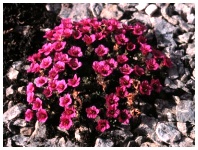
 Spectacular Displays of Wildflowers Unlike Antarctica, much of the Arctic is free of snow and ice during the summer months. This, along with the long hours of sunlight, allows for much plant growth on the open tundra. Plants in the high Arctic only have three months to grow (June to August), but during this time, spectacular displays of wildflowers occur. Many plants have leaves or flowers that are dark colors. This allows the plant to absorb more heat from the sun in the cold Arctic climate. The tundra is often covered with rocks, and the constant freezing and thawing of the landscape helps to break the rocks into smaller pieces. This provides shelters and anchorages in the harsh environment for the little plants and their seeds. And Arctic birds and animals also help in the process by distributing seeds. When they eat the brightly colored berries, they carry seeds to other places. If they "deposit" them on fertile and sheltered ground - more plants!
Click pictures for more information and credits. Library: Arctic, Land, Birds, Animals Environment/Atmosphere Links: Arctic, Environment Arctic Maps & Weather Reports |

|
DICTIONARY: Just "double-click" any unlinked word on this page for the definition from Merriam-Webster's Student Electronic Dictionary at Word Central. |

|
ARCTIC LIBRARY & GLOSSARY: Check this section for an index of the rest of the things you really need to know about the Arctic. |

|
ARCTIC MAPS & WEATHER REPORTS: Maps of the Northwest Passage, explorers' routes, iceberg sources, Nunavut, the Arctic by treeline, temperature... |

|
ARCTIC LINKS: Even more information! Links to sites related to the Arctic and "Iceberg: the Story of the Throps and the Squallhoots". |

|
GUIDE TO ARCTIC SUNRISE & SUNSET: How much sunlight or darkness is there in the Arctic on each day of the year? |
to is the property of their respective owners, and Athropolis is not responsible for their content.